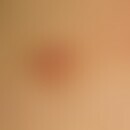Synonym(s)
HistoryThis section has been translated automatically.
DefinitionThis section has been translated automatically.
Autosomal dominant inherited blistering disease manifested at birth with scarring blistering below the lamina lucida of the basement membrane of the epidermis (subepidermal - dermolytic blistering). The blistering genodermatosis (like all dystrophic epidermolyses) is due to a mutation in the COL7A1 gene, which codes for collagen VII, a structural protein essential for the stability of the anchoring fibrils in the dermoepidermal basement membrane.
You might also be interested in
EtiopathogenesisThis section has been translated automatically.
Autosomal-dominant inheritance of a mutation of the COL7A1 gene mapped on the gene locus 3p21.3 Gene product is collagen type VII.
ManifestationThis section has been translated automatically.
Clinical symptoms already detectable at birth
Clinical featuresThis section has been translated automatically.
Integumentary:
- Generalized, disseminated skin involvement with localized or confluent blisters of various sizes and extensive erosions, but without mutilations, healing is very delayed, with flat, white atrophic scars. Frequent formation of milia. Subungual blistering is typical, leading to partial or total nail loss; scarring alopecia (blistering at the capillitium with scarring healing) is less common.
- In dominant dystrophic epidermolysis, there is an increased risk of malignancy , which is reported up to the age of 30 (!) for basal cell carcinoma with a probability of occurrence of 0.9% and for malignant melanoma with a probability of occurrence of 0.8%.
Extracutaneous involvement:
- Iron deficiency anemia(10-25%).
- Involvement of oral mucosa with residual leukoplakia (50-75%).
- Enamel defects (10-25%), note: mutant structural proteins interfere with odontomorphogenesis!
- Involvement of the digestive tract (10-25%)
HistologyThis section has been translated automatically.
Subepidermal blistering. Electron microscopic: Dermolytic blistering below the lamina densa. Anchoring fibrils rudimentary or reduced in number.
Differential diagnosisThis section has been translated automatically.
TherapyThis section has been translated automatically.
Symptomatic, see below. Epidermolysis bullosa group.
If necessary, topical glucocorticoids or intralesional injection with triamcinolone acetonide (Volon A-10 crystal suspension diluted 1:3 to 1:5 with physiological NaCl solution).
Surgical removal of individual affected areas with coverage is recommended.
In infancy, trial with high-dose vitamin E (tocopherol acetate) 25 mg/day/kg bw.
LiteratureThis section has been translated automatically.
- Cockayne EA (1938) Recurrent bullous eruption of the feet. Br J Dermatol Syph (Oxford) 50: 358-362
- Cockayne EA (1933) Inherited Abnormalities of the Skin and Appendages. (London) Oxford University Press
- Elliot GT (1895) Two cases of epidermolysis bullosa. Journal of Cutaneous and Genitourinary Diseases (Chicago) 13: 10-18
- JD et al (2000) Revised classification system for inherited epidermolysis bullosa: Report of the Second International Consensus Meeting on diagnosis and classification of epidermolysis bullosa. J Am Acad Dermatol 42:1051-1066
- Fine JD et al (2008) The classification of inherited epidermolysis bullosa (EB): Report of the Third International Consensus Meeting on Diagnosis and Classification of EB. J Am Acad Dermatol 58:931-950
- Fivenson DP et al (2003) Graftskin therapy in epidermolysis bullosa. J Am Acad Dermatol 48: 886-892
- Herlitz O (1935) Congenital non-syphilitic pemphigus: An overview and description of a new form of the disease. Acta Paediat 17: 315-371
- Höger P (2005) Child dermatology. Schattauer Publisher Stuttgart S 235-236
- Kon A (1997) Novel glycine substitution mutations in COL7A1 reveal that the Pasini and Cockayne-Touraine variants of dominant dystrophic epidermolysis bullosa are allelic. J Invest Dermatol 109: 684-687
- Laimer M et al (2015) Hereditary epidermolysis JDDG 13: 1125-1134
- Shirakata Y et al (1993) High-dose tocopherol acetate therapy in epidermolysis bullosa siblings of the Cockayne-Touraine type. J Dermatol 20: 723-725
- Touraine A (1955) in: L'hérédité en medicine. Masson (Paris) 448-449
- Unger K (1992) Epidermolysis bullosa dystrophica Cockayne-Touraine. Z Hautkr 67: 74
Incoming links (4)
Cockayne-touraine syndrome; Dermolysis transient, bullous of the newborn; Dystrophic epidermolysis bullosa ; Epidermolysis bullosa dystrophica albopapuloida;Outgoing links (4)
Epidermolysis bullosa hereditaria (overview); Glucorticosteroids topical; Milia; Triamcinolone acetonide;Disclaimer
Please ask your physician for a reliable diagnosis. This website is only meant as a reference.











